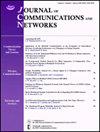Deep-learning-aided fast successive cancellation decoding of polar codes
IF 3.2
3区 计算机科学
Q2 COMPUTER SCIENCE, INFORMATION SYSTEMS
引用次数: 0
Abstract
With the continuous evolution of 5G communication technology to B5G and the next generation of communication technology, Deep Learning technology will also lead the automation and intelligent transformation of communication systems. Existing research has shown that the combination of deep learning and communication technology is expected to break some performance bottlenecks of traditional communication algorithms and solutions. This paper explores the application of deep learning (DL) in polar decoding algorithms, proposing a DL-aided-FSC (DL-FSC) polar code decoder algorithm. For the DL-FSC decoding algorithm, the conventional successive cancellation (SC) decoder is partitioned into multiple sub-blocks, which are replaced by R0 nodes, R1 nodes and sub-DL decoder. The log-likelihood ratio (LLR) and frozen bit pattern are input to the sub-DL decoder to predict decode codewords under any decoding code rate. Through simulation verification, under the PBCH channel of 5G communication, the DL-FSC decoder achieves similar block error rate (BLER) performance to the SC decoder, even improving by about 1%. In order to verify the performance optimization effect of the proposed algorithm at the hardware level, the DL-FSC deocder circuit design was completed. Through FPGA synthesis, the proposed decoder achieves a throughput of about 4571 Mbps, which is 1.71× improvement in decoding throughput at the expense of increased logic resources.深度学习辅助的极性码快速连续对消译码
随着5G通信技术向B5G及下一代通信技术的不断演进,深度学习技术也将引领通信系统的自动化、智能化转型。已有研究表明,深度学习与通信技术的结合有望打破传统通信算法和解决方案的一些性能瓶颈。探讨了深度学习(DL)在极坐标译码算法中的应用,提出了一种DL-aided- fsc (DL- fsc)极坐标译码算法。DL-FSC译码算法将传统的SC译码器划分为多个子块,由R0节点、R1节点和子dl译码器代替。将对数似然比(LLR)和冻结位模式输入到子dl译码器中,以预测任意译码率下的译码字。通过仿真验证,在5G通信的PBCH信道下,DL-FSC解码器实现了与SC解码器相似的块错误率(BLER)性能,甚至提高了约1%。为了在硬件层面验证所提算法的性能优化效果,完成了DL-FSC解码器电路设计。通过FPGA合成,所提出的解码器实现了4571 Mbps左右的吞吐量,在增加逻辑资源的代价下,解码吞吐量提高了1.71倍。
本文章由计算机程序翻译,如有差异,请以英文原文为准。
求助全文
约1分钟内获得全文
求助全文
来源期刊
CiteScore
6.60
自引率
5.60%
发文量
66
审稿时长
14.4 months
期刊介绍:
The JOURNAL OF COMMUNICATIONS AND NETWORKS is published six times per year, and is committed to publishing high-quality papers that advance the state-of-the-art and practical applications of communications and information networks. Theoretical research contributions presenting new techniques, concepts, or analyses, applied contributions reporting on experiences and experiments, and tutorial expositions of permanent reference value are welcome. The subjects covered by this journal include all topics in communication theory and techniques, communication systems, and information networks. COMMUNICATION THEORY AND SYSTEMS WIRELESS COMMUNICATIONS NETWORKS AND SERVICES.

 求助内容:
求助内容: 应助结果提醒方式:
应助结果提醒方式:


